The “Magical” Castles of Romania
By Melline Galani
You may have an idea or two about the multitude of castles that have been built throughout history in Romania. It may not have even crossed your mind that they would almost reach a number as high as one hundred, without taking into account the manors and the fortresses that join them. Our castles preserve between their walls medieval stories about voivodes (governors) and kings, hide legends and bloody battles, or bathe in jewelry and treasures – castles that seem to rise from a rock and that give even more charm to a country that has so much to offer.
I have always been in love with the Middle Ages, and its stories are about my favorite period of history. I would read Dumas’ stories of medieval France and its rival England, and I would transpose these stories onto real scenery every time I would visit a castle. I cannot take credit for visiting all one hundred castles in Romania, but I will describe the three I love the most.
The Royal Residence – Peleș Castle
Peleș Castle is one of the most beautiful and unique castles that Romania has, built by the first King of Romania, Carol I of Hohenzollern, between 1873 and 1914. By 1883, the year of its inauguration, it was used as a summer residence. Between 1890 and 1914, under the supervision of the Czech architect Karel Liman, considered the main architect, the castle was transformed and enlarged. In its original form (1883), both exterior and interior stylistic dominance was provided by the German neo-Renaissance style with two exceptions, the neo-Ottoman and the neo-Rococo styles. In the second stage (1890–1914), fundamental changes to the volumes, façades, and interior enriched the previous stylistic range, adapting the castle to the stylistic pluralism of Historicism. Royal details carved in lime and walnut wood, authentic Persian rugs, marble, books with leather covers and gold letters, Italian Neo-Renaissance style decorations, Hispano-Moresque elements, and crystal chandeliers are just some of the interior design elements of the castle. When I think about it, there are thousands of different styles, but at the same time they are perfectly uniform.

This castle represents one of the most important historical buildings in Romania and in Europe in the second half of the 19th century. After a visit to Sinaia, Prince Carol I remained very impressed by the beauty of the surroundings, so he decided to build a summer retreat there. In 1875, the foundation stone of the castle was laid, under which 20 gold coins were buried, these being the first Romanian coins minted with the face of Carol I. Three hundred laborers worked on the construction of the castle, finishing the building in about two years.
Peleș Castle has 160 rooms and several entrances and interior stairs with the central tower being 66 meters high. It also has a theater hall, with a small stage and 60 seats, plus the royal lodge. This castle was an extraordinary work of architecture at the time it was built, being unique in all of Europe due to its central heating system, its elevator, and the glass ceiling of the Hall of Honor, which was mobile and could be moved by an electric motor. Also due to having its own power plant, Peleș Castle was the first fully electrified castle in Europe. In addition to this castle, Pelișor, the Guard Corps, the Foișor Hunting House, the Stables, the Power Plant and the Șipot Villa were built. Around it, the castle has seven terraces decorated with stone statues, fountains and ornamental Carrara marble vessels.
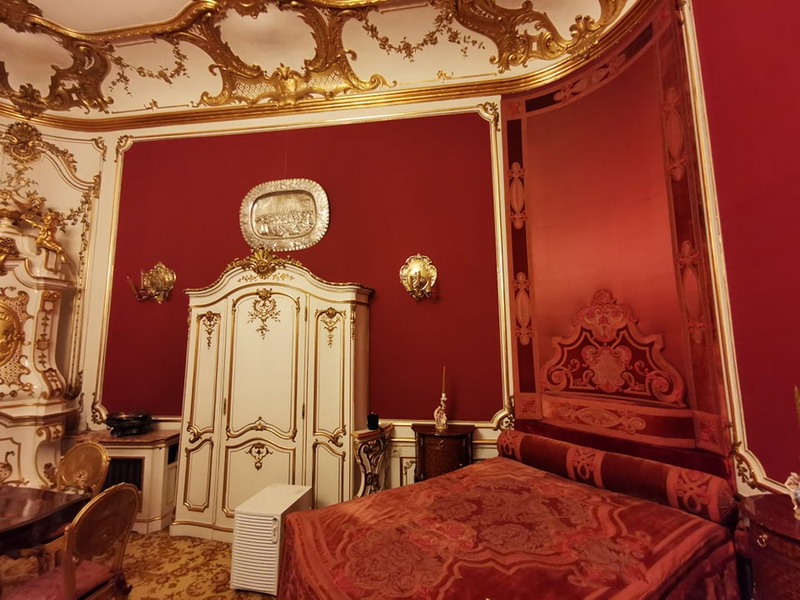
A personal property of the Royal Family from the beginning, Peleș Castle was confiscated by the communist regime after King Michael was forced to abdicate and leave the country by the communist government in 1947, and in 1953 it became a museum. Between 1975 and 1990, Nicolae Ceaușescu, the communist leader of the country at the time, ordered the closure of the domain to the public, the only persons accepted were those of maintenance, military, and security personnel. In 1990, the castle is opened to the public, and in 2006, the Romanian government announced the return of the castle to former King Michael I of Romania, the de facto owner. The date of restitution to the royal family was February 20, 2007. The castle has remained as the private property of the Royal House, but the former king expressed his desire that the castle should continue to shelter the Peleș National Museum, as well as being occasionally used for public ceremonies organized by the former royal family.
Peleș Castle is a real gallery, where great currents and trends in painting, sculpture, and decorative arts meet – a place full of history, which has hosted crowned heads and visionary artists as well as being the residence of the creator of modern Romania, King Carol I. It is the expression of his desire to affirm and legitimize the Romanian people among the modern nations of Europe.
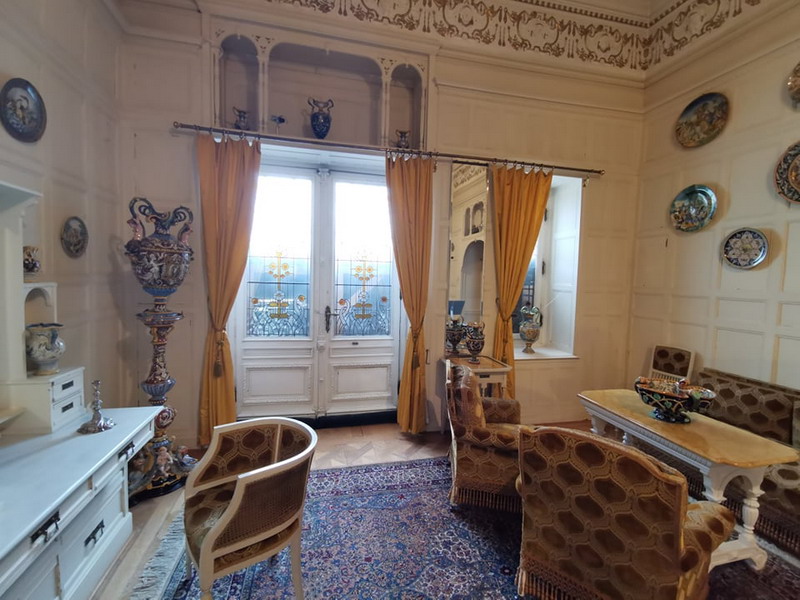
Dracula’s Nest – Bran Castle
Bran Castle is probably the best known castle of Romania because of its association with Bram Stoker’s novel Dracula. It is also the most visited castle in my country by both Romanians and international tourists.
The castle was built more than 600 years ago and was originally a fortress known as Dietrichstein, built by the Teutonic knights in 1212 and was conquered by the Germans in the late thirteenth century. In 1377 King Louis I of Hungary authorized the Transylvanian Saxons of the Brașov region to build a castle as protection against the northward expansion of the Ottoman Empire. The castle was completed in 1388, and it also served as a customs house for Transylvania, then a province of Hungary. In the early 15th century, King Sigismund of Hungary temporarily handed over possession of the castle to Prince Mircea the Old of Walachia, an adjoining territory that was being menaced by the Ottoman Turks. In 1441 János Hunyadi (Iancu de Hunedoara – Romanian), governor of Transylvania, defeated an Ottoman army at the castle.
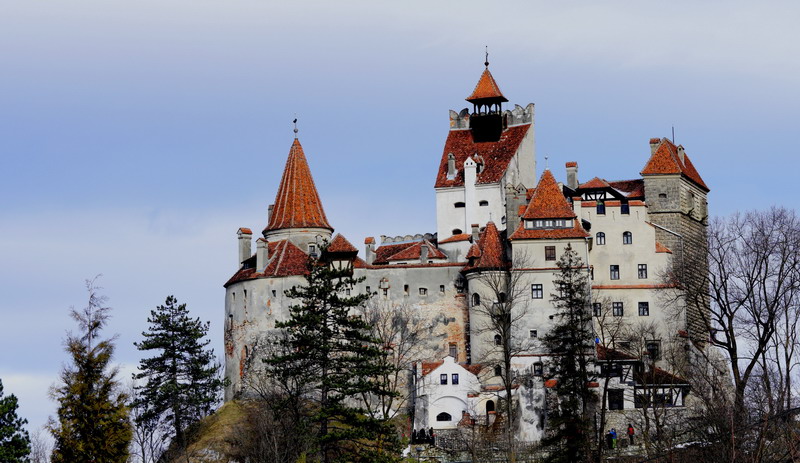
In 1498, the Transylvanian Saxons of Brașov bought the castle from King Vladislas II of Bohemia and Hungary, and they continued to hold it even after the conquest of the Hungarian capital by the Ottoman sultan Suleiman the Magnificent in 1541. During the 1620s, the Transylvanian prince Gábor Bethlen made extensive modifications and fortifications. The House of Habsburg gained control of the region in 1687, but the castle remained in Transylvanian hands. Under local control, the castle was restored several times for service as a fortress, most recently in the 1880s, but it fell into disrepair thereafter.
In 1920, the city of Brașov turned Bran Castle over to Queen Marie of Romania, who restored the castle as a royal summer residence and lived there both before and after the death, in 1927, of her husband King Ferdinand I. Between 1920 and 1929, Bran Castle underwent its most important restoration work under the leadership of the architect of the royal court, Carol Liman. During this period the building lost more and more of its strategic aspect, receiving instead residential functionalities. The neoclassical and eclectic styles, present in our country at the beginning of the 20th century, to which romantic elements are added, can be identified in Carol Liman’s conception of restoration. The queen also built the castle’s principle modern outbuilding, the Tea House, which later became a restaurant. Marie died in 1938 and her daughter, Princess Ileana, was forced out of the country by the new communist regime in 1948. The communists opened the castle to the public as a museum in 1956. Ileana died in 1991, and in 2009 the post-communist Romanian government handed over the castle to her heirs, Archduke Dominic of Habsburg, Archduchess Mary Magdalene, and Archduchess Elizabeth. The castle continues to operate as a museum.
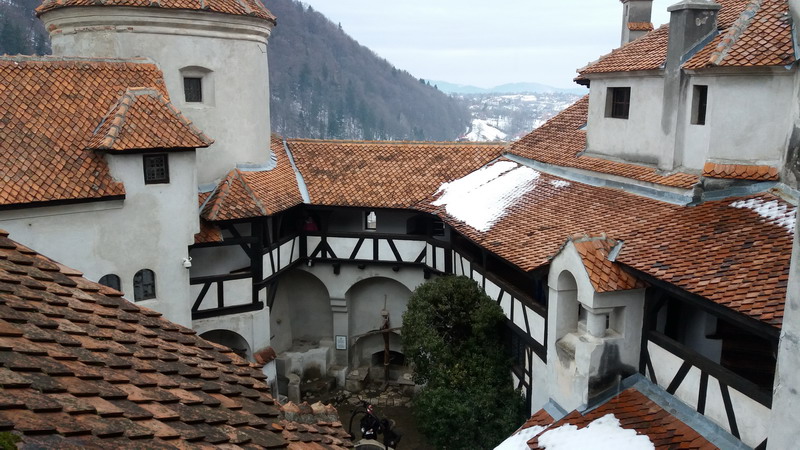
The main reason foreign tourists choose to visit Bran Castle is the legend that was created around it by the fictional character Dracula. Count Dracula first appears in the novel Dracula, written by the author Bram Stoker and published in 1897 in England. Originally, the name “Dracula” was not a scary one. It derives from the name given to an order of crusaders, the Order of the Dragon, which has been associated with both Vlad Tepeș and Vlad Dracul. The rest is influenced by the legends and popular beliefs about ghosts and vampires in Transylvania.
Currently, the four-story museum exhibits collections of furniture, costumes, weapons, and armor, and the Bran Domain also includes the Royal Park with its two lakes, the Tea House, the Administrator’s House, and the Princess Ileana House. The interior architecture of the castle is impressive, noting the plastered walls, the brick floor, the wooden ceilings, and the stone vaults in an exciting combination. The windows are dug into the thick walls built of rock and boulders. The first floor is accessed through the courtyard via a staircase with oak steps and a semi-cylindrical vault.
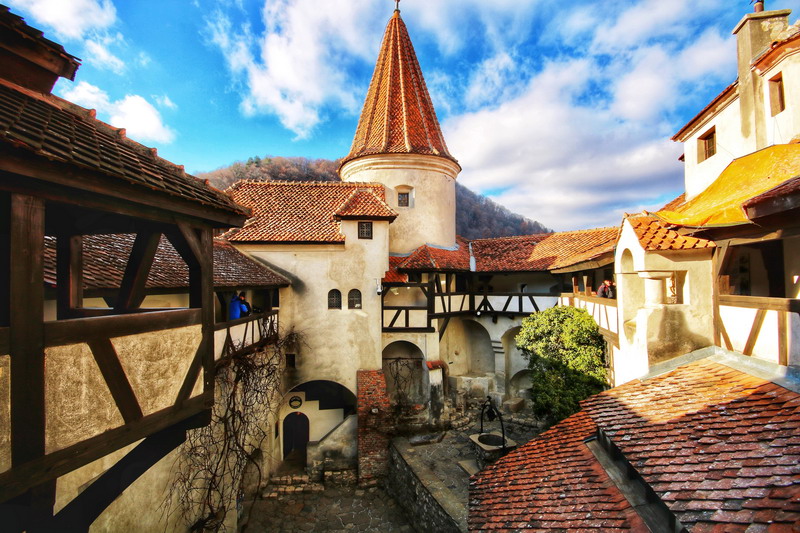
One of the main attractions of the castle is the Secret Passage, which was once known only to soldiers. If the invaders managed to enter the fortress, the soldiers used this passage to climb to the top of the castle from where they threw stones and hot tar at the attackers to drive them away. The entrance to the passage was made at that time through the mouth of a stove, located in the place where a door is now.
The Romanian castle resembles Castle Dracula as described in Bram Stoker’s novel in that both stand on rocky precipices and command spectacular views. But Stoker is not known to have ever visited Transylvania. Moreover, Vlad the Impaler, the historical personage most closely identified with Stoker’s Dracula, never ruled Bran Castle, although some sources claim that he was held prisoner there for two months. Vlad, grandson of Mircea the Old, was a 15th-century voivode of Walachia.
Another important factor would be the fact that several films have been made at Bran Castle over the years, but the one that had the biggest impact, I think, was Interview with a Vampire, an American horror film from 1994, which was partially filmed there.
The Gothic – Corvin Castle
I have always felt a special bond with this castle from the very first time I set foot on its land more than twenty-five years ago. I consider it a magical land with special energies and vibrations creating a strong energetic and spiritual knot. Corvin Castle, also known as Hunedoara Castle, is a Gothic-Renaissance castle in Hunedoara City (Romania) and one of the largest in Europe. The first owner of this Gothic architectural monument was Prince Voicu, the father of János Hunyadi (Iancu de Hunedoara), who received the castle as a gift from King Sigismund I of Luxembourg.
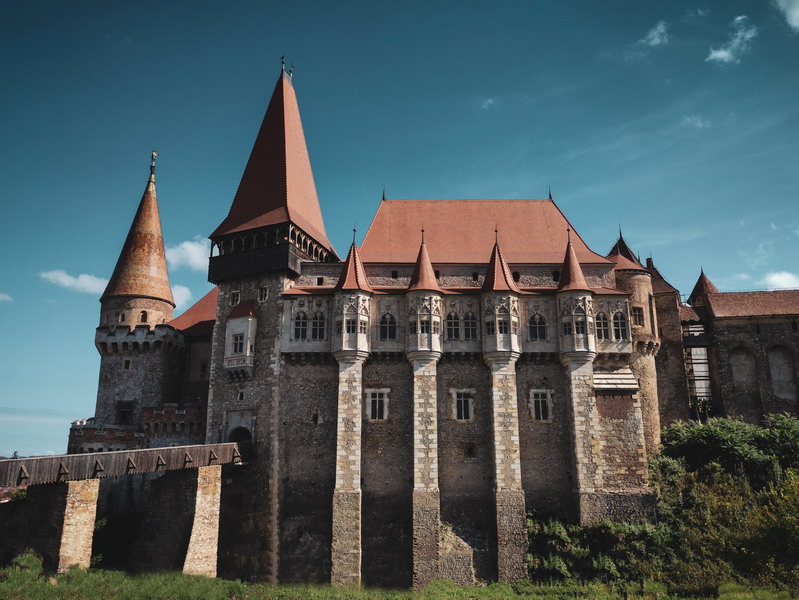
Accessed via a wooden bridge supported by four massive stone pillars above the smaller Zlaști Stream, the castle is a large and imposing structure with tall towers, bastions, an inner courtyard, diversely colored roofs, and myriad windows and balconies adorned with stone carvings. The castle also features a double wall for enhanced fortification and is flanked by both rectangular and circular towers, an architectural innovation for the period’s Transylvanian architecture. Some of the towers (the Capistrano Tower, the Deserted Tower, and the Drummers’ Tower) were used as prisons.
The first major structure is the new gate tower, rectangular in shape, a tower that impresses with its massiveness. The ground floor area has the appearance of a vaulted space, noting the presence of the guard post where there is a fireplace. From here you can easily reach the castle prison, which has a massive wooden door.
The castle has three large areas: Knight’s Hall, Diet Hall, and the circular stairway. The halls are rectangular in shape and decorated with marble. Diet Hall was used for ceremonies or formal receptions while Knight’s Hall was used for feasts. In 1456, Iancu de Hunedoara died, and work on the castle stagnated. Starting with 1458, new commissions were being undergone to construct the Matia Wing (north wing) of the castle. The Matia Loggia is a wing located to the left of the exit of the New Gate Tower and is considered the earliest manifestation, in the field of architecture, of the Renaissance. On the floor of the loggia are preserved the only Transylvanian secular fresco paintings from that period. In 1480, work was completely stopped on the castle, and it was recognized as being one of the biggest and most impressive buildings in Eastern Europe.
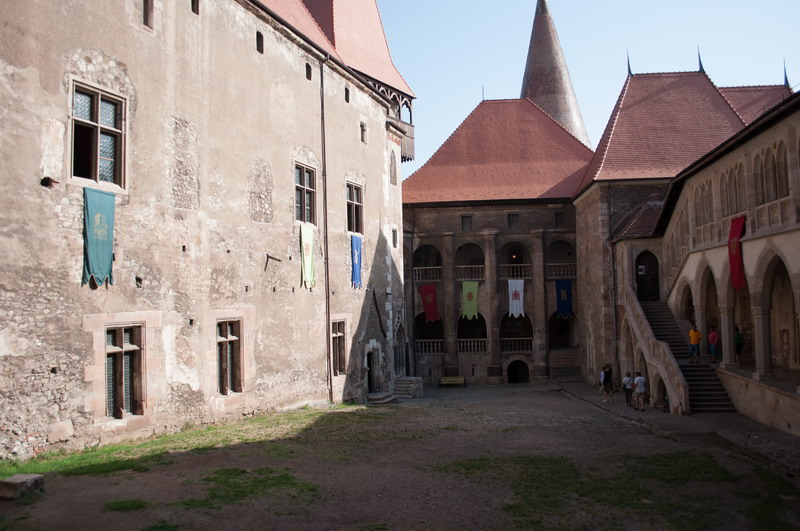
The 16th century did not bring any improvements to the castle, but during the 17th century new additions were made for aesthetic and military purposes. Aesthetically, the new Large Palace was built facing the town. Being a two-level building, it hosted living chambers and a large living area. For military purposes, two new towers were constructed: the White Tower and the Artillery Tower. Also, the external yard was added for administrative and storage purposes.
The current castle is the result of a fanciful restoration campaign undertaken in 2019 after a disastrous fire and many decades of total neglect. The uniqueness of this castle in Hunedoara comes from its highly representative nature of military architecture in the southeast of Europe in the 15th century, with it meeting the most developed elements of civil architecture. The Grand Palace was a French-inspired building, unique in an area dominated by the Hungarian Kingdom at the time, illustrating the greatness of an important family able to borrow architectural models from a place that hosted one of the most brilliant medieval civilizations: France.
Though traveling is still complicated these days, a simple search on YouTube can satisfy one’s curiosity. If you want to know more about these amazing and fantastic places, please give the internet a try.
The Author
Melline Galani is a Romanian enthusiast, born and raised in the capital city of Bucharest, and is currently living in Gwangju. She likes new challenges and learning interesting things, and she is incurably optimistic. Melline loves living life as it is. Instagram @melligalanis






